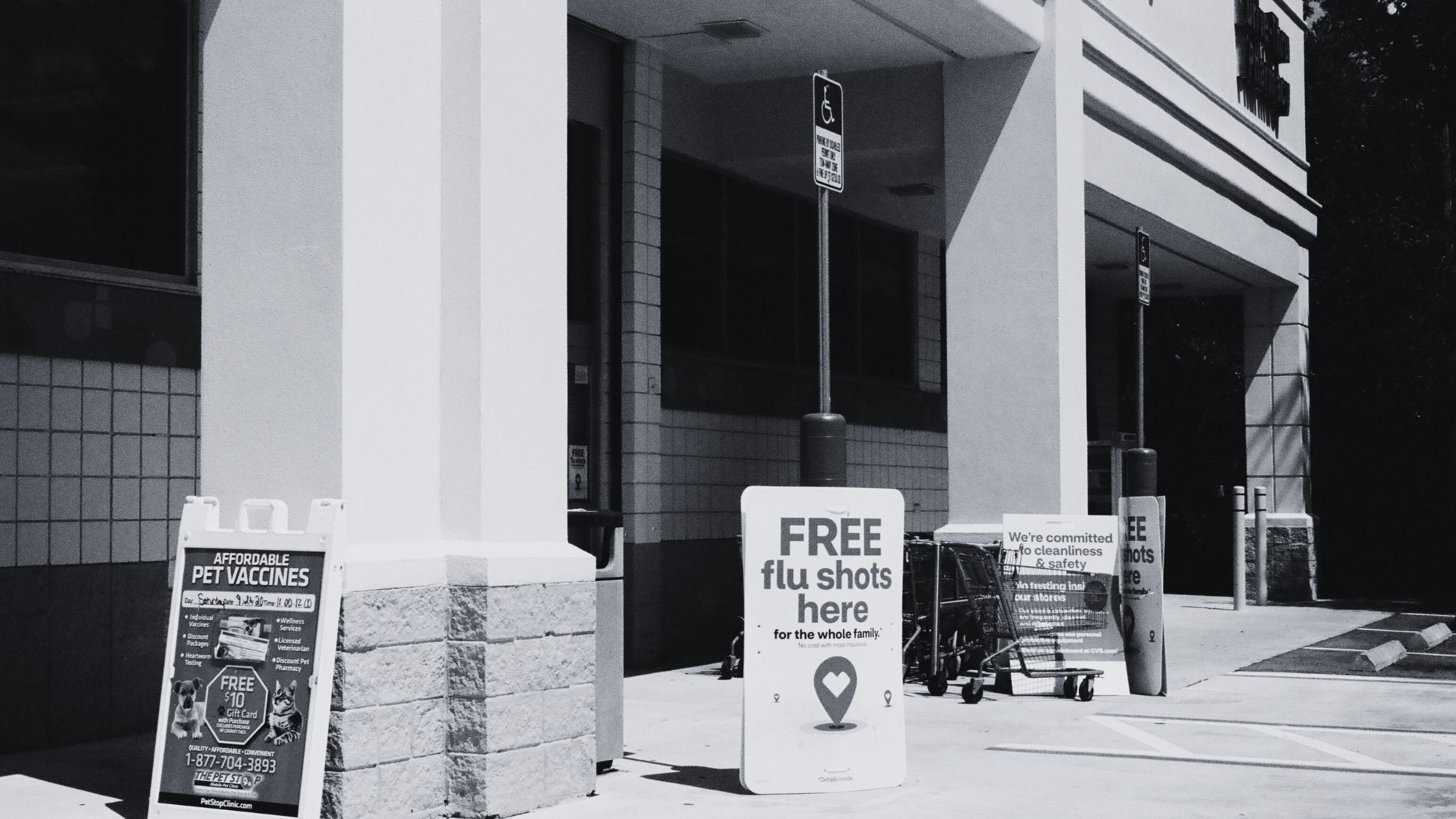Walgreens pharmacies (the Walgreens Boots Alliance) and CVS are large pharmacy chains in the US. Both have many stores and offer similar products are services as direct competitors. What is baffling for many consumers is how many of these brands’ stores are located close to each other; in walking distance, next to each other, or on opposite sides of the road!
This bold strategy of placing a store next to a competitors is an intriguing one. Let’s explore why CVS and Walgreens have this unique relationship and what it means for their performance.
At pass_by, we offer the highest in market accuracy with 94% correlation to ground truth, over 15 data inputs, and a full 90 days of predictive feeds. Book a call now.
Jump to:
Where are CVS and Walgreens stores located?
It’s a well known fact that 90% of Americans live within 5 miles of a pharmacy. It’s also true that 85% of Americans living within 5 miles of a CVS pharmacy and 75% within 5 miles of a Walgreens.
Walgreens and CVS stores are all over the US. As you can see from our foot traffic heat maps, both chains are spread across the US and compete in similar areas, though Walgreens has a wider spread in the midwest while CVS is slightly more concentrated.
At pass_by, we offer the highest in market accuracy with 94% correlation to ground truth, over 15 data inputs, and a full 90 days of predictive feeds. Book a call now.
Why are CVS and Walgreens stores close to each other?
Placing your store directly next to or close to a direct competitor is usually considered to be the worst option in site selection.
CVS and Walgreens, however, have found ways to stay competitive and frequently choose to set up shop right across the street from one another. Is it a coincidence or by design?
Not every CVS and Walgreens store is right on top of the other. When it does happen, it is definitely by design. This decision making process is driven by strategic business choices and market dynamics.
Data analysis
Firstly, it’s about market research. Both CVS and Walgreens use extensive location data analysis and competitive intelligence to identify the best locations for their stores. They look for high-traffic areas, proximity to other retail stores, and demographics that match their target customer base. It often turns out that the best spots for one pharmacy giant are also ideal for the other.
In the Star Tribune, CVS spokesman Mike DeAngelis agreed that it’s not surprising that his company and Walgreens often wind up so close to each other, because both are looking for the same things: population density, visibility, easy access. The presence of senior housing is key, he said.
One stop shop
Secondly, there is a psychology at play. These stores know that customers often value convenience and the ability to compare options. By being next to each other, they create a one-stop hub for consumers who need to fill prescriptions, buy health essentials, or grab some snacks and toiletries.
Their competitive proximity often leads to both businesses thriving rather than one knocking the other out. Price wars, promotions, and superior customer service become the tools of engagement. This rivalry can be beneficial to customers as it often means better deals and more choices.
Hotelling’s model of spatial acquisition
This theory explains that placing a business next to a competitor may be aggressive competition, but it does mean each business can (in theory) gain the highest possible number of visitors. While CVS and Walgreens are known for being close by, other businesses such as Burger King and McDonalds, clothing stores, and mobile phone stores all compete in close proximity.
So, the next time you see a CVS and a Walgreens side by side, understand that it’s a calculated strategy. They are leveraging their strengths to ensure that customers have easy access to their stores, knowing that convenience can drive loyalty and sales.
What’s the difference between CVS and Walgreens?
All information correct as of June 2024.
CVS and Walgreens have many similarities. Both are pharmacy chains. The layout and products available in these stores might look quite similar, but each chain has its unique offerings and loyalty programs. CVS, for example, has the ExtraCare card that gives discounts and rewards, while Walgreens offers myWalgreens.
| CVS | Walgreens | |
| Number of stores | 9,395 | 8,250 |
| Average daily visits per store | 895 | 873 |
| Loyalty program | Yes – ExtraCare | Yes – myWalgreens |
| Average age of visitor | 45-49 | 45-49 |
| Average daily visits per store | 895 | 873 |
| May 2023-2024 YoY revenue | +3.58% | +4.7% |
| Net worth(as of March 3 2023) | $30.52 billion | $104.57 billion |
At pass_by, we offer the highest in market accuracy with 94% correlation to ground truth, over 15 data inputs, and a full 90 days of predictive feeds. Book a call now.
CVS and Walgreens visitor comparison
All top visitor types to CVS and Walgreens are within 1% of the proportion of the national population, apart from High Society Families which are 1.14% higher than the population in visits to CVS. Both retailers have a well-balanced visitor profile.
When comparing the two, our data found that CVS had fewer School Run Family visitors. These families are usually large and have multiple children.
Another notable difference is that Walgreens has a higher percentage of suburban household visitors – these are settled families with a medium-income level.
However, both have a similar level of middle-class manager visitors.
In short, there are some differences in visitor type, but the overall profile is very similar and perhaps another reason why these retailers stay so close is place their stores in ideal locations for these demographics.
What’s the difference between CVS and Walgreens performance?
Both CVS and Walgreens have increased their sales revenue by over 3% in the second quarter of 2024.
CVS’s total revenues increased to $88.4 billion, up 3.7% compared to prior year.
The current environment does not diminish our opportunities, enthusiasm, or the long-term earnings power of our company. We are confident we have a pathway to address our near-term Medicare Advantage challenges. We remain committed to our strategy and believe that we have the right assets in place to deliver value to our customers, members, patients, and shareholders.
Karen S. Lynch, CVS Health President and CEO
The U.S. Retail Pharmacy segment of Walgreens had 2024 second quarter sales of $28.9 billion, an increase of 4.7% from the year-ago quarter.
Most of Walgreen’s pharmacies growth in recent times has been from prescriptions and their pharmacy sales. The brand’s retail sales dropped by 4.5%, citing a “a challenging retail environment, channel shift, and a weaker respiratory season.”
Retail sales decreased 4.5 percent and comparable retail sales decreased 4.3 percent compared with the year-ago quarter, reflecting a challenging retail environment, channel shift, and a weaker respiratory season.
Both CVS and Walgreens are large pharmacy chains facing similar challenges in the retail space, however both are increasing sales revenue through other angles.
Who visits CVS and Walgreens?
Our analysis of visitors to CVS and Walgreens chains from January – April 2024 found that the two pharmacy chains have a similar average demographic.
The average visitor is aged 45-49, a high school graduate, earning between $75 – 90,000 a year, working in health and social care, and drives alone to the store.
At pass_by, we offer the highest in market accuracy with 94% correlation to ground truth, over 15 data inputs, and a full 90 days of predictive feeds. Book a call now.
Does the proximity of CVS and Walgreens influence their pricing strategies?
Yes. Being in close proximity to a direct competitor means price wars are inevitable. These price wars can attract customers looking for the best deal. Each brand may offer sales or discount prices on in-demand items and trending products to steal customers away from their neighbor.
This close competition can mean competitive prices for customers. Through sales wars, promotions, and even loyalty programs, both CVS and Walgreens aim to offer the best deal possible to get customers in-store and coming back.
Book a call now with our team for further information on how you can use location data to analyse your competitors and the wider market.





